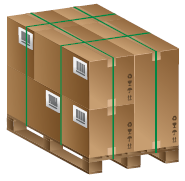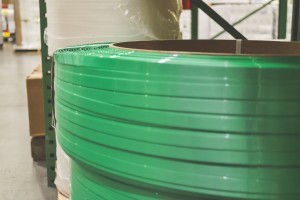
Strapping: You've heard of it, but what do you really know about it?
Strapping is one of the most commonly used means of unitization and bundling in the packaging industry. There are multiple types of strapping products available, as well as many application types, but strapping is especially used in environments such as:
- Bundling together for handling and shipping: newspapers, pipe, lumber, concrete block, etc.
- Attaching items to pallets, skids, and crates
- Reinforcing wooden boxes, crates, and corrugated boxes, such as gaylords
- Attaching items to flatcars, flatbed tractor trailers, etc.
- Securing a unit load of bricks, packaged glass, metal parts, etc.
- Closing corrugated boxes and shipping containers
- Securing coils of steel or paper
- Holding bales of agricultural products or textiles
- Load securing items within intermodal containers, boxcars, and tractor trailers
Strapping is most often used in complete horizontal or vertical bands. Typically, edge protectors are used to help spread the strap’s tension on the load at corners and reduce damage caused by that tension. Strapping can also be used in loops attached to holding locations such as rail cars, tractor trailers, or skids.
Main types of strapping available
Steel strapping: steel is the oldest, strongest, and highest tensile strength strapping available. It is available in a variety of widths and thicknesses, as well as variations in the grade of steel. Steel is used for heavy duty holding where high strength and minimal stretch are desired, as well as when the product may be sharp or hot.
When it comes to knowing if you need something as heavy duty as steel strapping for your shipping, ask yourself these three questions:
- Is the load heavy and stable?
- Does it need to travel a long distance?
- Will it need to be loaded and unloaded many times before destination?
If the answer to these questions is yes, then you will have the most success with steel strapping.
Plastic strapping: Polypropylene and polyester strapping are the main types of plastic strapping today. Polypropylene strapping is an economical material designed for light to medium duty unitizing, palletizing, and bundling. It is available in various widths, thicknesses, and polymer variations (e.g., copolymers). This product offers higher elongation, but tends to have irrecoverable dead stretch with constant stress. Polyester strapping is the most rigid option, offering the strongest plastic strapping, and is used as a viable alternative to steel in many industries. Polyester provides excellent retained tension on rigid loads and its excellent recovery properties help a load absorb impact without strap breakage. It has significantly less elongation than polypropylene and retains tension over a longer period of time.
Plastic strapping, in general, is often referred to collectively as “poly strapping” despite its specific differences. It can create some confusion, but by remembering these useful pieces of advice to best tell them apart:
- Polypropylene strap is typically embossed, feels more like plastic, and has a matte-style finish.
- Polyester is a glossy, smooth strap; it does not resemble polyester fabric in any way.
- Since polypropylene is the most common plastic strap option, the term “poly strapping” will generally refer to polypropylene.
- Polyester works best when you need higher initial tension; polypropylene is best when high initial tension is unimportant and only low retained tension is needed.
Because of its long history in the packaging world, there are lots of different types of strapping today; however, most strap is made from either steel or plastic. Each has their own advantages and disadvantages, making it critical to figure out exactly what works for your specific needs.
In order to better understand strapping, its advantages and disadvantages, as well as its characteristics, it is important to understand the main terms used in the industry:
- Tension: any form of pushing or pulling to tighten a strap
- Elongation: the amount of stretch in the strap as tension is applied
- Elongation recovery: the strap's ability to return to its original state after tension is removed
- Working range: elongating the strap to a point where it wants to recover, but not so much that it can’t recover; it is the sweet spot when strap will perform to the best of its ability
- Tension decay: over time, tension will diminish; polyester exhibits the least amount of tension decay, while polypropylene shows the largest amount
- Tensile strength (or break strength): the amount of force, in pounds, required to break a strap
- Core size: the diameter and depth of one coil of the strap; this must correspond to the dispenser or machine being used with the strapping
- Thickness: the physical thickness of the strap, measured in fractions of an inch
- Width: the physical width of the strap; it must correspond with the tools or machine being used to apply the strap
A final word on elongation and tension
 What are you strapping? This will determine what kind and what size strapping product you'll need. Let one of our Specialists help.
What are you strapping? This will determine what kind and what size strapping product you'll need. Let one of our Specialists help.Remember: steel strapping has no give. So, if you need some elongation, you'll need to go with a plastic strapping. All plastic strapping materials elongate under tension and recover a portion of the elongation as stress is relieved. The latter quality - the elongation recovery of the plastic strapping - enables the straps to contract when the package shrinks. Steel strapping, on the other hand, elongates a small amount, but has 100% recovery below the yield point. Plastic strapping materials will vary in their capacity to elongate and recover. Before choosing among the plastic strapping on the basis of elongation recovery, three questions must be asked:
- How much elongation recovery is required? (This is most important on loads that will shrink.)
- How much tension can be pulled on the strapping material without damaging the product?
- How much retained tension (creep) is allowed?
Keep in mind the following:
- Polyester strapping elongation recovery will be approximately 70%.
- Polypropylene strapping elongation recovery is 20 to 40% depending on the initial tension.
- Humidity has no effect on the elongation recovery of polyester strapping or polypropylene strapping. However, temperature has an adverse effect on all plastic strapping materials, but significantly more on polypropylene strapping.
For more information on strapping, check out our Definitive Poly and Steel Strapping Guide. Then pick up the phone and talk to one of our knowledgeable Product Specialists about how strapping can help change the face of your packaging, forever.





